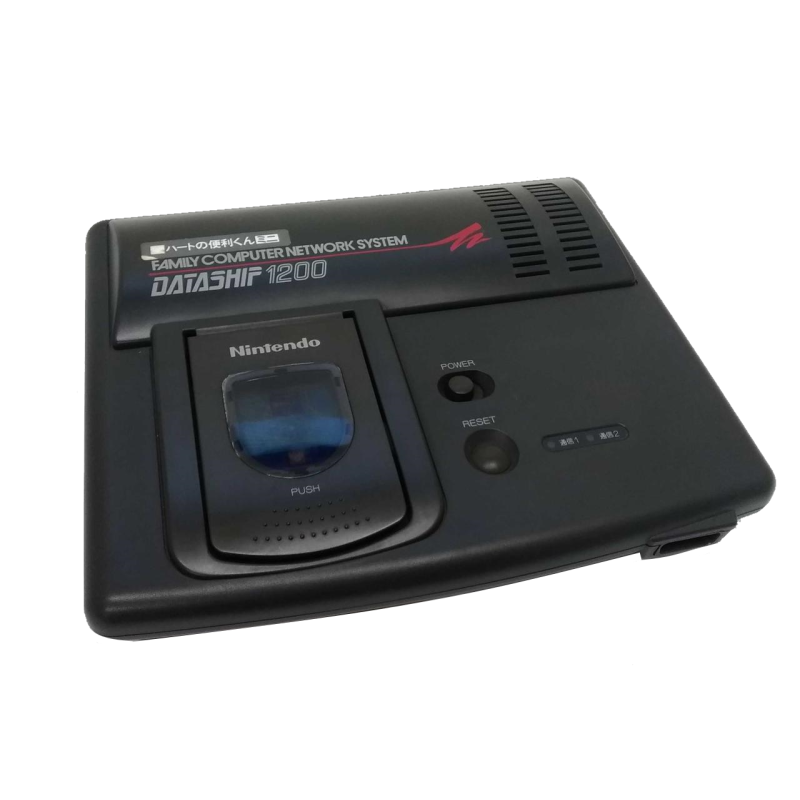|
History
Before the release of the Family Computer (Famicom) system in 1983, the Japanese video game landscape was in its infancy. Aside from the Cassette Vision which had a moderate success, video game console was not something you would typically see in a Japanese home. The release of the Famicom drastically change that. All of a sudden, many homes that didn’t have a microcomputer now had a Famicom, which was, in essence, a computer dedicated to play video games. By 1985, the president of Nintendo, Hiroshi Yamauchi, understood that connecting the Famicom could be use to access online service such as stock trading. He name his concept the Family Computer Network System and tasked Masayuki Uemura, General Manager of Nintendo R&D2, to develop the services. Nintendo selected Nomura Securitie, s company specializing in financial services partnered to develop the Famicom Network System. The system was a device that would attach to the Famicom which would allow it to connect to some online services. The device itself was essentially a modem combined with a tsuushin cartridge (通信カートリッジ) reader. These cartridges, also known as Communication Cartridge, were sold separately and would provide a range of services, most notably in the financial industry (stock exchange, banking transaction), but also provide services such as horse race betting or, to a very limited extent, online gaming. Even Nintendo used this system for toy shops in Japan to deliver Famicom-title game reviews to customers.
While Nintendo developed the Famicom Network System, Micro Core released the TV-NET and Bridgestone released the FAM-NET, all imcompatible with the upcomming Family Computer Network System.
In 1990, some banks, including Dai-ichi Kangyo Bank, one of the largest banks in the world at the time, wanted to push further the concept with a business device that could read the Nintendo’s tsuushin cartridges. As Nintendo already had all the technology, it was only a matter of combining the Famicom system and the Famicom Network System in the same machine.
Sharp, which was already a strong Nintendo partner when it comes to created Famicom related devices, was involved to some extent in the production process.
Release
In 1990, the DataShip 1200 was formally released. The console was bundled with the Famicom ANSER card which allows the user to connect to the Bank ANSER System (Automatic answer Network System for Electronic Request). The Dai-ichi Kangyo Bank had their own version of the DataShip 1200, that was identical to the standard release except for a sticker above the name of the console and that it came bundled with the “Heart’s Handy-kun Mini” communication cartridge, which would allow to connect to the Dai-ichi Kangyo Bank online services. As the system was designed for businessmen, it was made to look like an office equipment and not a gaming console. The Dataship 1200 also cannot play Famicom game natively. And although the electronic is based on the Famicom system, it needs to be modified heavily to be able to do so. Gaming was still possible on the system with the Konami Tsuushin Shogi Club online services. Nintendo also had plans to develop other online games, but none were ever commercially produced.
The DataShip 1200 had the ability to connect to a printer and had an extension port that was never used.
Demise
Sadly, the market segment targeted by the DataShip 1200 was very slim. It turned out that most people would prefer the more gimmicky look of the Famicom combined to a Famicom Network System and to get the ability to play games than to have a slick looking machine that serves only one purpose.
The name and model suggest that a version with higher dataspeed (higher than 1200 bit/s), but the very low sale number of the DataShip 1200 killed any glimmer of hope to see a second revision.
Tsuushin Cartridges
Here’s a list of known cartridges. Other surely exist.
Numbered tsuushin cartridges (FNC0XX-YY):
- FCN000-05: Famicom ANSER [ファミコンアンサー] [1989]
- FCN000-08: Super Mario Club (Blue) [スーパーマリオクラブ] by Nintendo [1990]
- FCN000-09: Super Mario Club (Red) [スーパーマリオクラブ] by Nintendo [1991]
- FCN001-01: Nomura no Famicom Trade (Black) [野村のファミコントレード]
- FCN001-03: Nomura no Famicom Trade (Blue) [野村のファミコントレード]
- FCN001-05: Nomura no Famicom Trade (Orange) [野村のファミコントレード]
- FCN002-01: Yamatane no Famicom Trade [山種のファミコントレード]
- FCN003-01: Cosmo’s Famicom trade [コスモのファミコントレード]
- FCN004-01: Wako no Famicom Trade [和光のファミコントレード]
- FCN005-01: Okasan’s Famicom trade [岡三のファミコントレード]
- FCN006-01: Shin Nihon no Famicom Home Trade [新日本のファミコントレード]
- FCN006-03: Shin Nihon no Famicom Home Trade [新日本のファミコントレード]
- FCN006-07: Kangyo Kakumaru Famicom tradee [勧業角丸のファミコントレード]
- FCN009-01: Sanyo no Famicom Passport [三洋のファミコンパスポート]
- FCN011-01: Sanwa Personal Banking Pegasus [三和パーソナルバンキング ペガサス]
- FCN014-01: Hāto no benri-kun mini [ハートの 便利くん ミニ] [1989]
- FCN017-01: Kinkiginkō tasukerumini [近畿銀行タスケルミニ]
- FCN026-01: Tsuushin Shogi Club [将棋倶楽部] by Konami [1990]
- FCN027-02: JRA-PAT
- FCN027-04: JRA-PAT
- FCN027-05: JRA-PAT
- FCN027-06: JRA-PAT
- FCN030-01: PIT Motorboat Race
- FCN030-02: PIT Motorboat Race
- FCN030-03: PIT Motorboat Race
- FCN050-01: Sumitomo hōmurain [住友ホームライン]
Unnumbered tsuushin cartridges:
- Yamato’s My Trade [大和のマイトレード] (Pink Popeye)
- Yamato’s My Trade [大和のマイトレード] (Yellow Popeye)
- Yamato’s My Trade [大和のマイトレード] (Futuristic city)
- Pisuto [ピスト]
- Universal My Trade [ユニバーサルのマイトレード]
- JRA-PAT
- Home Trading One [日興のホームトレードワン]
- Yamaichi Securities Sunline F-I [山一證券 サンラインF-I]
- Yamaichi Securities Sunline F-II [山一證券 サンラインF-II]
- Yamaichi Securities Sunline F-III [山一證券 サンラインF-III]

